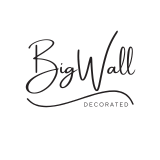Did you know the global pallet market is set to hit $86 billion by 2027? This shows how popular pallet wood is becoming for home projects, like wall coverings. In this guide, we’ll show you how to make a beautiful pallet wood wall. It will change the look and feel of any room.
Covering a Wall with Pallet Wood
Key Takeaways
- Pallet wood is a budget-friendly and sustainable material for DIY wall projects.
- Careful selection and preparation of pallet wood are crucial for a successful installation.
- Proper planning and design can create a visually appealing and cohesive pallet wood wall.
- Attention to detail during the installation process ensures a sturdy and durable finish.
- Maintenance and care tips help preserve the natural beauty of the pallet wood wall over time.
Understanding the Appeal of Pallet Wood
In the world of interior design, reclaimed wood wall coverings have become very popular. Pallet wood is at the center of this trend. It has won the hearts of many, including homeowners, designers, and DIY fans. So, why do people love using pallet wood for rustic wall covering?
What Makes Pallet Wood Popular?
Pallet wood is loved for its unique look and feel. Each piece has its own story, with weathered surfaces and natural marks. This adds a rustic charm and makes any space feel warm and welcoming.
Benefits of Using Pallet Wood for Walls
- Affordability: Pallet wood is cheap, making it great for those on a budget.
- Sustainability: Using pallet wood helps reduce waste and supports eco-friendly living.
- Customization: You can easily make pallet wood fit any design, from modern to industrial.
- Unique Character: Its natural imperfections give each space a unique look.
Pallet wood’s rustic charm and eco-friendly benefits make it a top choice for reclaimed wood wall coverings and rustic wall projects.
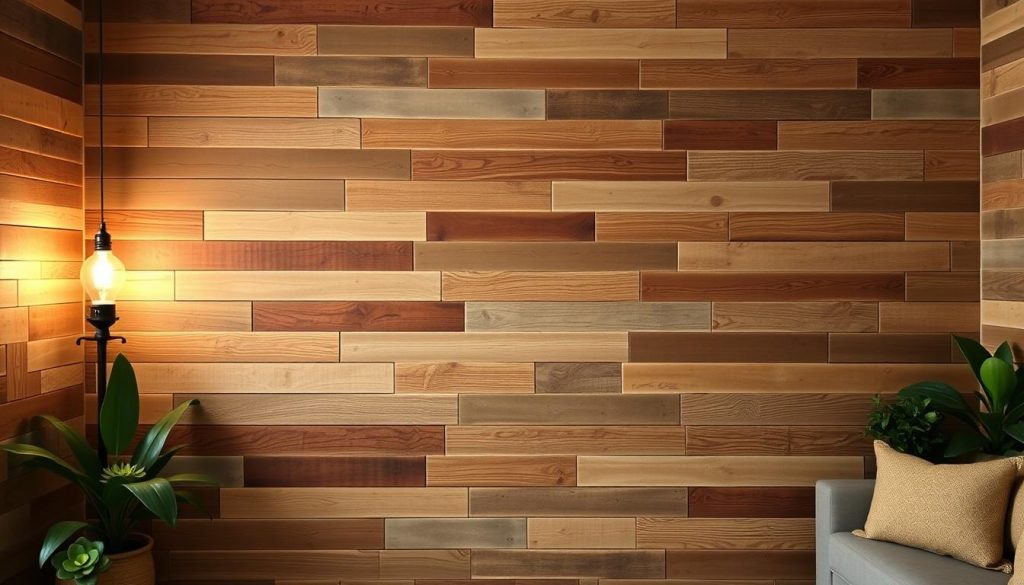
Selecting the Right Pallet Wood
Starting an upcycled pallet project or adding a salvaged wood wall treatment to your home begins with choosing the right pallet wood. There are many types of pallet wood, each with its own features. Knowing these can help you pick the best for your project, ensuring a great outcome.
Types of Pallet Wood Available
The main types of pallet wood include:
- Hardwood pallets, such as oak and maple, which are strong and great for heavy tasks.
- Softwood pallets, like pine and spruce, which are lighter and cheaper but less sturdy.
- Treated pallets, which resist moisture and pests, perfect for outdoor projects.
- Untreated pallets, best for indoor use since they can’t handle the weather as well.
Sourcing Quality Pallet Wood
Getting high-quality pallet wood is key for any upcycled pallet project or salvaged wood wall treatment. Look for pallets that are in good shape, without too much wear, damage, or pest signs. Good places to find clean pallet wood include reputable suppliers or local businesses that sell reclaimed materials. Stay away from pallets that carried hazardous materials or show contamination.
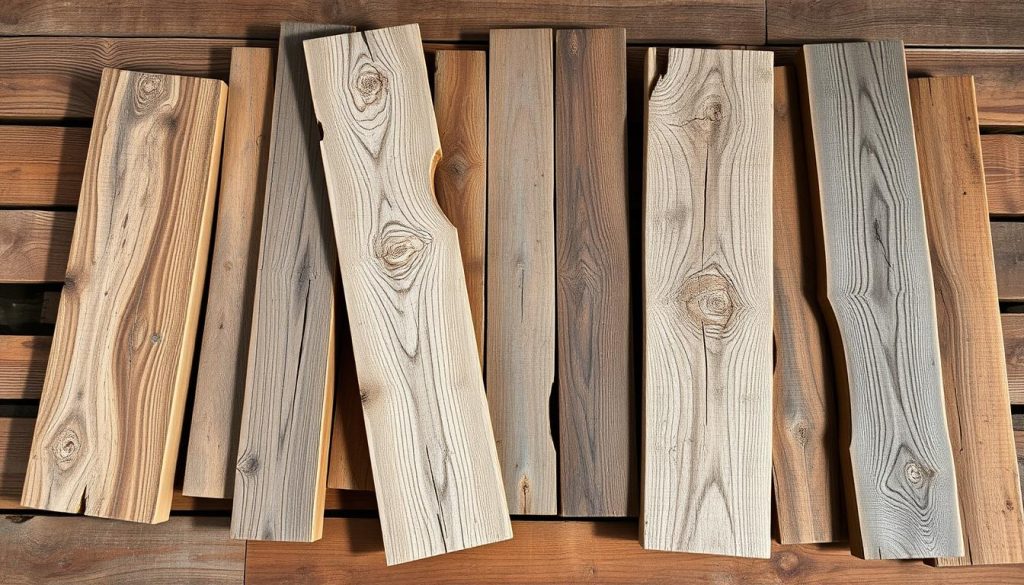
“Selecting the right pallet wood is the foundation for a beautiful and long-lasting wall treatment.”
Tools and Materials You Will Need
Turning a wall into a pallet wood masterpiece is a fun DIY task. But, you need the right tools and materials to do it right. This guide will help you get everything you need for your pallet wood wall project.
Essential Tools for Pallet Wood Installation
- Pry bar or crowbar to disassemble pallets
- Circular saw or miter saw for cutting pallet wood to size
- Nail gun or hammer for securing the wood panels
- Drill and drill bits for pre-drilling holes
- Measuring tape and pencil for accurate measurements
- Safety goggles, gloves, and a dust mask for protection
Additional Materials for a Successful Project
For your wood panel installation or pallet wood accent wall project, you’ll need more than just tools. Here’s what else you’ll need:
- Wood glue or construction adhesive to bond the panels
- Finishing nails or screws for a sturdy installation
- Sandpaper in varying grits for smoothing the surface
- Stain, sealant, or other finishing products (optional)
- Painter’s tape or edge guards to protect surrounding areas
Having these tools and materials ready will make your pallet wood accent wall project easier and more fun.
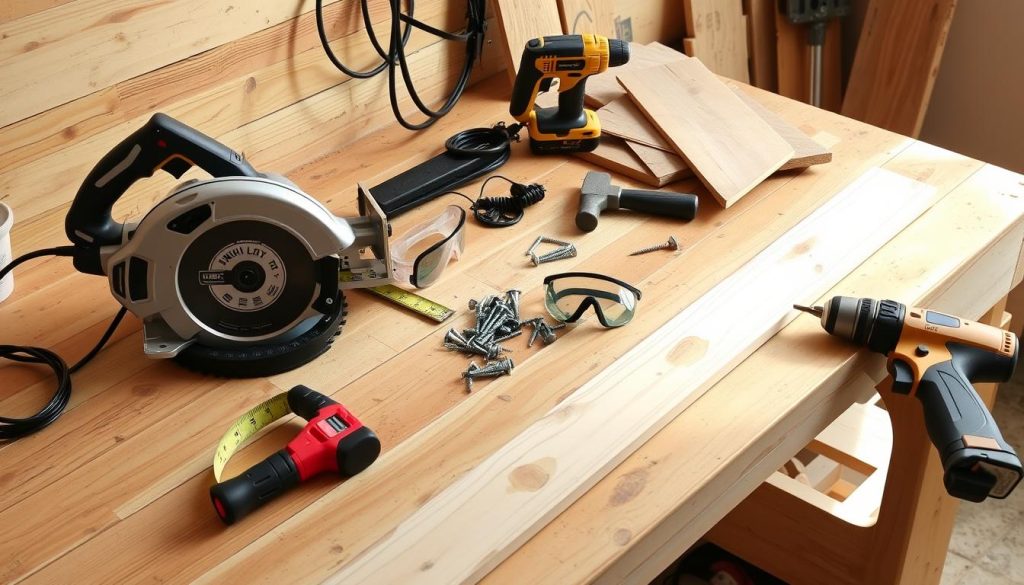
Preparing the Wall for Pallet Wood
Before starting your pallet wood wall project, you need to prepare the wall first. This step is key to a successful DIY wood feature wall. It will make your space look better.
Cleaning the Surface
Begin by cleaning the wall well. Take off any old wallpaper, paint, or dirt that might get in the way. Use a scraper or sander to make the surface smooth and even. This will get your wall ready for your covering a wall with pallet wood project.
Making Repairs Before Installation
Then, check the wall for cracks, holes, or uneven spots. Fix these with a patching compound and sand until smooth. Fixing these problems early will help your pallet wood look perfect.
If you find moisture issues, fix them right away. Make sure the wall is dry and free of water damage or mold. This is important to keep your pallet wood in good shape.
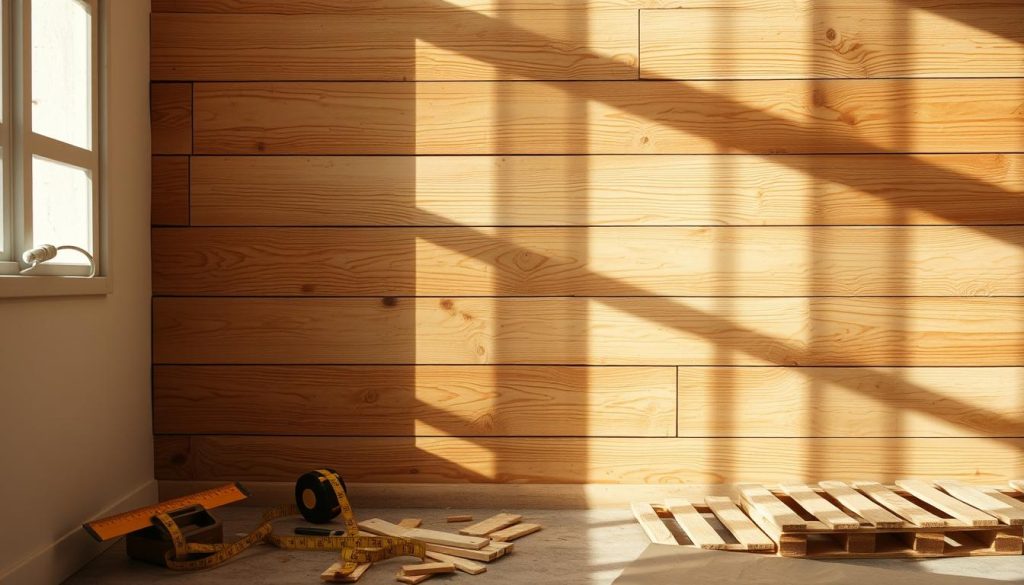
By preparing the wall well, you’re setting up for a great DIY wood feature wall. With a clean, even surface, you can start your project with confidence. Your pallet wood installation will turn out well.
Designing Your Pallet Wood Wall
Creating a stunning pallet wood wall starts with a good design. You can choose from rustic, modern, or eclectic styles. These choices greatly affect your space’s look and feel. Let’s dive into the world of wooden pallet wall decor and pallet wood interior design.
Choosing the Design Style
Pallet wood is versatile, allowing for many design styles. For a rustic look, go for the natural, weathered wood. For something modern, pick uniform boards and arrange them in geometric patterns. Or, mix different wood tones and textures for an eclectic look.
Planning the Layout
Planning is crucial for a stunning pallet wood wall. Think about the wood’s orientation: vertical, horizontal, or herringbone. Try out different layouts and colors to match your style. Add shelves, artwork, or lights to make your pallet wood interior design more interesting.
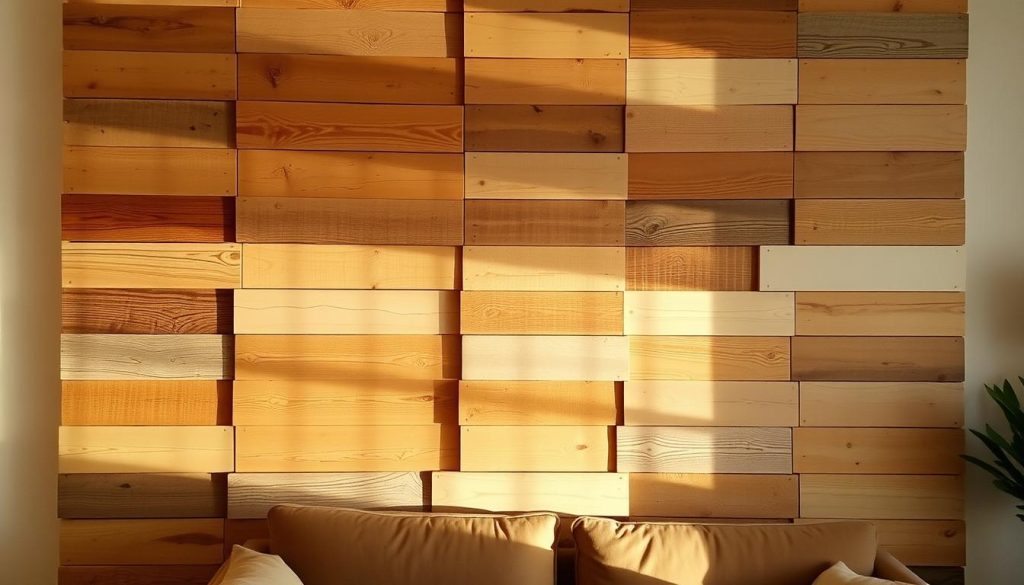
“The beauty of pallet wood lies in its imperfections. Embrace the unique character of each board to create a one-of-a-kind accent wall that reflects your personal style.”
The design process lets you show your creativity. It turns a plain wall into a stunning focal point. With planning and imagination, your wooden pallet wall decor can add warmth and character to your space.
Measuring and Cutting Pallet Wood
Creating a stunning wood panel or feature wall with pallet wood requires precision. Accurate measurements and clean cuts are key for a professional look. Let’s explore how to measure and cut your pallet wood perfectly.
How to Measure Accurately
Measuring correctly is crucial for a successful pallet wood project. First, inspect each pallet board for size and thickness variations. Use a tape measure or ruler to record the dimensions of the boards you’ll use. Note the length, width, and thickness, and any unique features or imperfections.
Cutting Techniques for Pallet Wood
Now that you have your measurements, it’s time to cut the wood. A miter saw or circular saw works best for straight cuts. Make sure the blade is sharp and follow safety rules when using power tools. For a rustic look, use a hand saw or jigsaw for irregular cuts.
Choose your cutting method wisely. Always double-check your measurements before cutting. Practice on scrap wood before starting your project. With patience and attention to detail, you’ll achieve a flawless wood panel or feature wall.
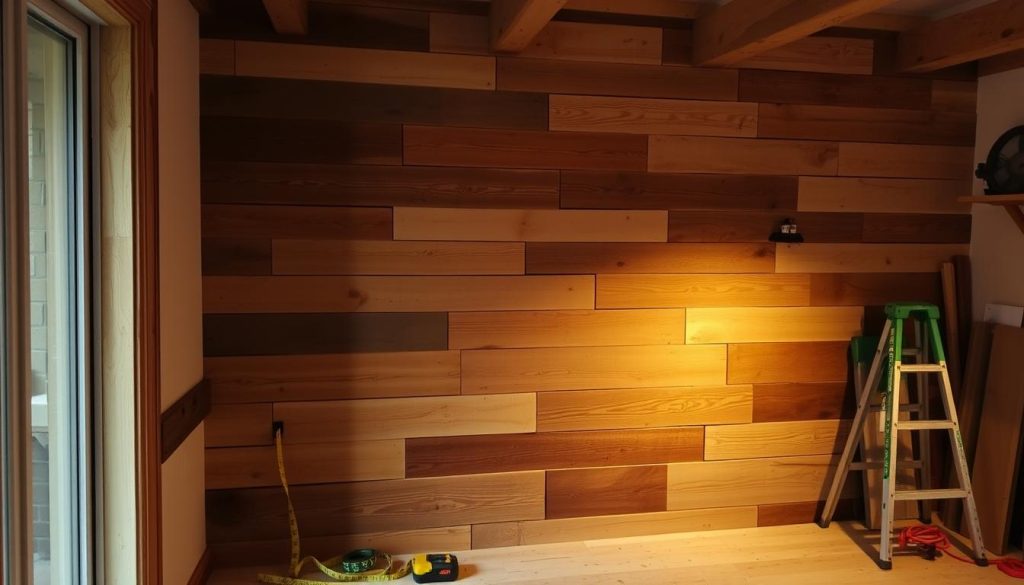
“Precision is the foundation of a stunning pallet wood feature wall. Take the time to measure and cut your boards with care, and you’ll be rewarded with a beautiful, one-of-a-kind result.”
Installing the Pallet Wood
Covering a wall with pallet wood is a fun DIY project. But, it needs careful attention to detail. By following a step-by-step guide and avoiding common mistakes, you can create a beautiful pallet wood accent wall. This will add warmth and character to your home.
Step-by-Step Installation Process
- Start with the first row: Begin by securing the first row of pallet wood at the bottom of the wall, ensuring it is level and straight.
- Work your way up: Continue installing the pallet wood panels, staggering the joints and maintaining a consistent pattern as you move up the wall.
- Fit around obstacles: Carefully measure and cut the pallet wood pieces to fit around electrical outlets, switches, and other wall-mounted fixtures.
- Secure the panels: Use finishing nails, wood glue, or a nail gun to securely attach the pallet wood panels to the wall, ensuring a sturdy and long-lasting installation.
- Finish with the top row: For a polished look, cap off the top row of pallet wood with a decorative trim or molding.
Common Installation Mistakes to Avoid
- Uneven spacing: Inconsistent spacing between the pallet wood panels can create an unprofessional appearance. Take the time to measure and align each piece carefully.
- Improper cutting: Inaccurate cuts can lead to gaps and uneven edges. Use a miter saw or circular saw to ensure clean, precise cuts.
- Insufficient fastening: Failing to properly secure the pallet wood panels can result in loose or unstable installation. Use the appropriate fasteners and adhesives for a durable, long-lasting finish.
- Neglecting wall preparation: Skipping essential wall preparation steps, such as cleaning and repairing the surface, can compromise the overall installation quality.
By following these best practices and avoiding common pitfalls, you can successfully install a visually stunning pallet wood accent wall. This will transform the look and feel of your living space.
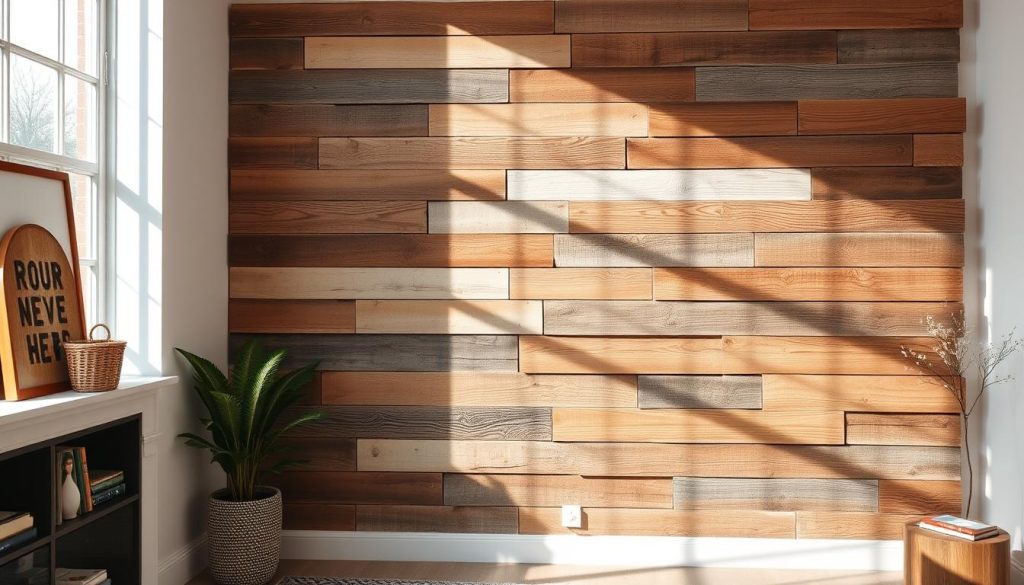
Finishing Touches for Your Pallet Wall
After installing your pallet wood wall, it’s time for the final touches. These steps will enhance the look and protect your investment. Sanding, staining, and sealing are crucial for a stunning pallet wood interior design.
Sanding and Staining Options
First, sand the wood to make it smooth and even. This removes rough spots and splinters. It prepares the surface for your chosen finish.
When staining, you can pick from many options. Choose from classic wood tones to bold colors. Find the perfect stain for your rustic wall covering look.
Sealing the Pallet Wood
- Apply a high-quality sealant to protect your pallet wood. It enhances the wood’s beauty and keeps it safe from moisture and wear.
- Use a clear polyurethane or lacquer sealant to keep the wood’s rustic look. These options are durable and won’t hide the wood’s natural beauty.
- For extra protection, try a wood wax or oil-based sealant. It nourishes and conditions the wood over time.
Choose finishing touches that balance and enhance your pallet wood interior design. With the right techniques and products, your pallet wall will become a stunning centerpiece.
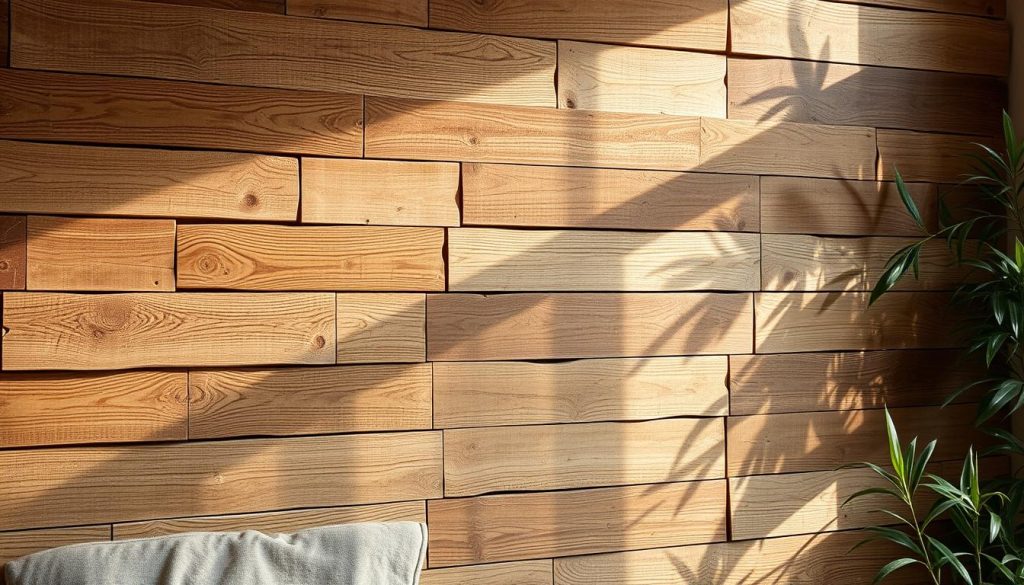
Maintenance and Care Tips for Pallet Walls
Keeping your wooden pallet wall decor or salvaged wood wall treatment looking great is key. With a few easy steps, your pallet wall can stay beautiful for many years.
Regular Cleaning Guidelines
Regular cleaning is vital for your pallet wall’s health. Start by dusting it gently with a soft-bristled brush or microfiber cloth. This removes dirt and debris.
For a deeper clean, use a mild wood-safe cleaner and a damp cloth. Be careful not to soak the wood. Stay away from harsh chemicals and rough scrubbers to protect the wood’s finish.
Repairing Damage on Pallet Walls
As time goes by, your wooden pallet wall decor might get scratches or scuffs. Use wood filler or putty to fix these. After it dries, sand it lightly to blend with the rest of the wood.
If you want to touch up the stain or color, use a matching wood stain or paint. Make sure to keep the pallet wood’s rustic look.
| Maintenance Task | Frequency |
|---|---|
| Dusting | Weekly |
| Mild Cleaning | Monthly |
| Repairing Damage | As Needed |
By sticking to these care tips, your salvaged wood wall treatment will stay a beautiful centerpiece in your space for years.
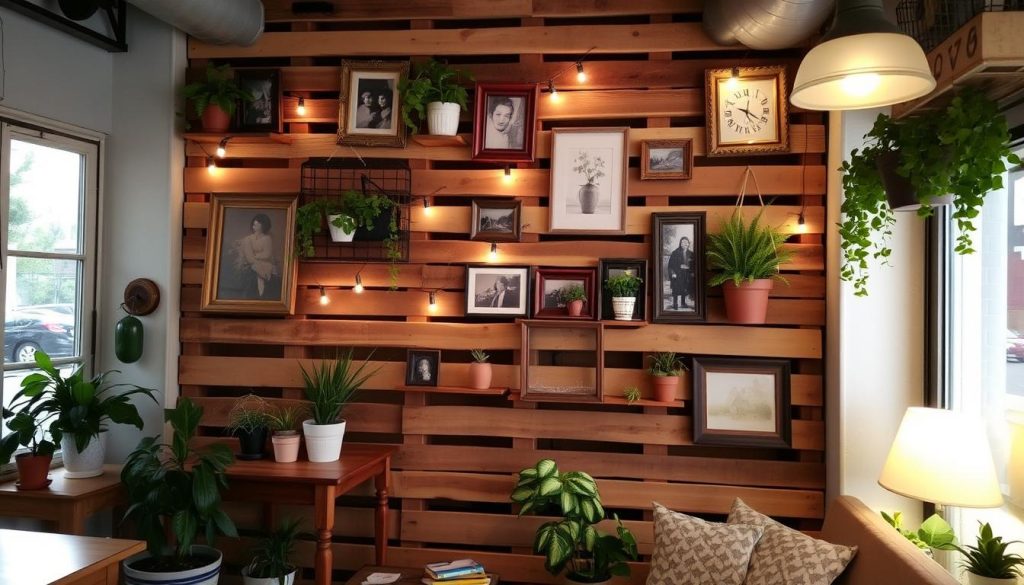
DIY vs. Hiring a Professional
When it comes to covering a wall with pallet wood, you have two options. You can do it yourself or hire a professional. Each choice has its own benefits and things to consider. Let’s look at the pros and cons of each to help you decide.
Pros and Cons of DIY Installation
Doing it yourself can save a lot of money on labor. It also gives you a sense of accomplishment and pride in your work. But, DIY projects can be challenging. You need to plan well, pay attention to details, and have the right skills for a smooth installation.
When to Consider Professional Help
While DIY can be rewarding, sometimes it’s better to hire a professional. If you don’t have the skills, tools, or time, a pro might be a better choice. They have the expertise, work efficiently, and can handle any unexpected problems.
Whether to DIY or hire a pro depends on your skills, preferences, and project needs. Think about the pros and cons to choose the best option for your budget and project.
Cost Considerations for Pallet Wood Walls
Building a reclaimed wood wall or an upcycled pallet project is rewarding. But, it’s crucial to think about the costs. You need to budget well to keep your project on track.
Budgeting for Your Project
The main cost is the wood. Reclaimed pallet wood is often free or cheap. But, remember to include the time and effort to prepare it. You’ll also need nails, screws, adhesives, and finishing products.
Potential Hidden Costs
- Wall preparation: You might need to fix or prepare your wall first. This can increase the cost.
- Specialized tools: While basic tools work, specialized ones can make your job easier and look better.
- Protective coatings: Sealing the wood keeps it looking good longer. This might cost more and take more time.
Think about all costs to make a detailed budget. This way, you can avoid surprises and finish your project beautifully. With careful planning, you can make a stunning reclaimed wood wall or upcycled pallet project without breaking the bank.
Real-Life Examples of Pallet Wall Installations
Pallet wood is now a favorite for making beautiful accent walls. It’s used in homes and businesses. These examples show how pallet wood can make a space look great, inspiring others to use it for pallet wood accent wall and wooden pallet wall decor.
Residential Projects
In a cozy living room, a pallet wood accent wall can make it feel warmer and more interesting. One homeowner turned a plain wall into a highlight by arranging and installing pallet wood. This created a textured background for their furniture and decor.
The natural wood grain and imperfections make the space unique and welcoming. It’s a cozy spot to relax.
For a modern farmhouse bedroom, another homeowner chose wooden pallet wall decor. They stained the pallet wood a warm, neutral color and arranged it horizontally. This created a stunning feature wall that fits the room’s minimalist style.
Commercial Applications
Pallet wood is also popular in commercial spaces for its rustic and trendy look. In a local coffee shop, the owners used pallet wood accent wall to make the place cozy and inviting. The pallet wood, combined with industrial-chic lighting and modern furniture, makes the space appealing and welcoming.
A local brewery also used wooden pallet wall decor in their taproom. The rough-sawn pallet wood adds a vintage vibe. It fits well with the industrial-inspired decor, making the space memorable for visitors.
Sustainability Aspects of Using Pallet Wood
When it comes to upcycled pallet projects and salvaged wood wall treatments, sustainability is key. Using pallet wood for home décor and DIY projects is eco-friendly. It’s a popular choice for those who care about the environment.
Eco-Friendly Benefits of Pallet Wood
Pallet wood is sustainable by nature. Pallets are made from cheap, easy-to-find lumber. This lumber would otherwise go to waste, harming the environment. By turning it into wall coverings or home accents, you help reduce waste and support a circular economy.
Recycling and Upcycling Options
- Pallet wood planks can be recycled or upcycled into many new items. This includes furniture, shelving, or even outdoor structures like fences or garden beds.
- Local organizations and recycling centers also accept used pallet wood. They can repurpose it in creative ways or break it down for sustainable use.
- Homeowners can disassemble and repurpose pallet wood themselves. This gives the material new life and reduces environmental impact.
By choosing pallet wood, you can create stunning upcycled pallet projects. This supports a greener future. The material’s versatility and durability make it perfect for sustainable home décor.
Final Thoughts on Creating a Pallet Wood Wall
Starting your project to turn a wall into a rustic pallet wood feature? Remember the important points from this guide. Good planning, quality materials, and patience are key to a beautiful pallet wood wall. This project lets you get creative and try out many designs.
Key Takeaways for a Successful Project
Always measure twice and cut once. This rule helps avoid mistakes. Make sure the wall is ready, pick the right tools and materials, and follow the steps carefully. You can also try different stains and finishes to make your wall unique.
Encouragement for First-Time DIYers
First-time DIYers, don’t worry! With the right help and effort, you can make your space special. Enjoy the process, celebrate your achievements, and be proud of your pallet wood wall. It might be tough, but the end result will make it all worth it.
FAQ
What makes pallet wood a popular choice for wall coverings?
Pallet wood is loved for its unique look, affordability, and eco-friendliness. It adds a rustic charm to any room. Plus, using pallets is a green way to decorate, fitting today’s trend of upcycling.
How do I select the right pallet wood for my project?
Choosing the right pallet wood is key. Look for wood that’s even, not damaged, and free of harmful substances. Also, get your wood from trusted sources for quality and safety.
What tools and materials do I need to cover a wall with pallet wood?
You’ll need a saw, hammer or nail gun, level, and safety gear like goggles. You’ll also need wood glue, nails or screws, and sandpaper for finishing. Having the right tools makes the job easier and better.
How do I prepare the wall for the pallet wood installation?
Start by cleaning the wall well to remove dirt and old materials. Then, fix any holes or uneven spots. A clean, even surface helps the wood stick well and look great.
What are some common mistakes to avoid during the pallet wood installation?
Avoid mistakes like bad measuring, wrong alignment, and using poor-quality pallets. Also, make sure to space the wood right and secure it well. This prevents problems later on.
How do I maintain and care for my pallet wood wall?
To keep your wall looking good, clean it often and fix any damage. Use a damp cloth or mild cleaner for dust and dirt. For bigger repairs, get help from experts or online guides.
When should I consider hiring a professional for my pallet wood wall project?
Consider a pro if you’re new to DIY, the wall needs a lot of prep, or you want it done right. Experts can help with design, layout, and finishing for the best look.
How can I budget for a pallet wood wall project?
When planning your budget, think about the cost of pallets, adhesives, fasteners, and tools. Also, include costs for wall prep and finishing touches. Remember to account for unexpected expenses to stay on track.





